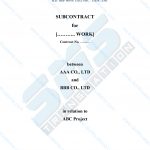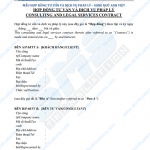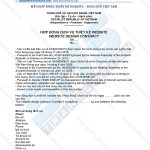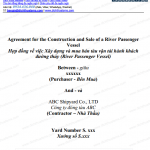NATIONAL TECHNICAL REGULATION OF MOTOR VEHICLE STRUCTURE WITH REGARD TO THE PREVENTION OF FIRE RISKS
- GENERAL PROVISIONS 1.1. Scope of adjustment
1.1.1. This Regulation prescribes the technical requirements and technical safety quality inspection for of motor vehicle structure with regard to the prevention of fire risks belonging to the categories of passenger cars, cargo automobiles (trucks), trailers and semi-trailers fitted tanks with liquid fuel (hereafter referred to as fuel tanks).
1.1.2. This Regulation does not apply to vehicles used for security, defense or other special purposes.
1.2. Subject of application
This Regulation applies for facilities producing, assembling and importing vehicles, facilities producing, importing fuel tanks and agencies, organizations and individuals involved in the testing, inspecting the Quality Certification of technical safety and environmental protection.
1.3. Interpretation of terms
In this Regulation, the terms below are construed as follows:
1.3.1. Vehicle type means the products of the same industrial owner, the same brand, design and specifications, manufactured in the same technological line. The vehicles do not differ on the following contents:
– The vehicle type; – The vehicle band;
– The dimensions and mass of the vehicle itself (the deviation does not exceed the permissible error limits specified in the current regulations and standards
– The number of people it is allowed to carry;
– The shape, structure of the cabin, frame or body of the vehicle; – The engine, transmission system;
– The type of fuel used;
– The structure, shape, dimensions and material of the tank; – The position of the tank in the vehicle;
– The characteristics and siting of the fuel feed system (pump, filters, etc.) in the vehicle; – The characteristics and siting of the electrical installation system in the vehicle.
– Braking system: Drive type, brake mechanism; – Steering system: Type of steering mechanism;
– Suspension system: Suspension type, structure type of flexible parts; – Movement system: Type of rigid axle;
– Special structure (if any).
1.3.2. Passenger compartment means the space for seating of the passengers in the vehicle, limited by roofs, ceilings, walls, doors, windows, front bulkheads and rear bulkhead surface or rear seat backrest of vehicle.
1
1.3.3. Fuel tank means containers designed for holding liquid fuel, used primarily for vehicle power.
1.3.4. Capacity of the fuel tank means volume of fuel tanks according to the regulation of the production facilities.
1.3.5. Liquid fuel means fuel at liquid state under normal temperature and pressure conditions.
1.3.6. Transverse plane means a vertical plane, perpendicular to the vertical median plane of the vehicle.
1.3.7. Unladen mass means the weight of a vehicle in running order, not carrying any passengers and goods but complete with fuel, coolant, lubricants, washer fluid, tools and spare wheel (if specified by the vehicle manufacturer).
1.3.8. Production, Import facility: Means an enterprise producing and importing components and enterprise producing, assembling and importing motor vehicles that meet all the conditions according to current regulations.
- TECHNICAL PROVISIONS 2.1. Regulations for fuel tanks
2.1.1. General requirements for fuel tanks
2.1.1.1. Tanks must be made so as to be corrosion-resistant of fuel.
2.1.1.2. The fuel tanks are normally attached to all their accessories, the leakage tests carried out according to provisions in section 2.1.2 of this Regulation.
Fuel tanks made of a plastic material are considered suitable if they meet the provisions in section 2.1.3 of this Regulation.
2.1.1.3. Any excess pressure or any pressure exceeding the working pressure must be compensated automatically by suitable devices (vents, safety valves, etc.)
2.1.1.4. The vents must be designed so that the fuel vapor escapes from the hole must not be able to fly into the passenger compartment or high temperature places such as the engine, exhaust system. Especially when the fuel tank is filled up with fuel, the leakage fuel must not fall on the exhaust system but shall be channeled to the ground.
2.1.1.5. The tank(s) must not be situated in, or from, a surface (floor, wall, and bulkhead) of the passenger compartment or other compartment integral with it.
2.1.1.6. The fuel must not escape through the tank top or through the devices provided to compensate excess pressure when vehicle is operating.
2.1.1.6.1. The filler cap should be fixed to the filler tube.
The stipulations in section 2.1.1.6.1 of this Regulation will be deemed to be satisfied if provision is made to prevent excess evaporative emissions and fuel spillage caused by a missing fuel filler cap.
This may be achieved using one of the following:
– A fuel filler cap is automatically opened, closed and non-removable;
– Design features which avoid excess evaporative emissions and fuel spillage in the case of missing the fuel filler cap;
– Any other provision which has the same effect. Examples may include, but are not limited to, a tether filler cap, a chained filler cap or one utilizing the same locking key for the filler cap and for the vehicle’s ignition. In this case, the key shall be removable from the filler cap only in the locked condition. However, the use of tethered or chained filler cap by itself is not sufficient for vehicles other than cars and trucks with a total mass not exceeding 3.5 tons.
2.1.1.6.2. The lock between the cap and the filler pipe must be retained securely in place. The cap must latch securely in place against the lock of filler pipe when closed.
2.1.1.7. The fuel tank(s) shall be made of a fire-resistant metallic material. The tanks may be made of plastic material in accordance with section 2.1.3 of this Regulation.
2.1.2. Requirement of the Tests for fuel tanks
The fuel tank must be tested according to Appendix A of this Regulation. 2.1.2.1. Requirement for leak testing by fluid
After testing in accordance with article A.1 in Appendix A of this Regulation, the fuel tank cover shall not be broken or leaked; however, tanks can be permanently deformed.
2.1.2. Requirement for leak when overturning
The rate-of leakage of the tank must not exceed 30g/min when tested in accordance with article A.2 in Appendix A of this Regulation.
2.1.3. Test for fuel tanks made of plastic
For fuel tanks made of plastic, outside of provisions in section 2.1.2, shall be tested in accordance with Appendix B of this Regulation
2.1.3.1. Collision resistance
After testing in accordance with section B.1 of Appendix B of this Regulation, the fuel tank must not leak.
2.1.3.2. Mechanical strength
After testing in accordance with section B.2 of Appendix B of this Regulation, the fuel tank and its accessories must not crack or leak; however, it may be permanently deformed.
2.1.3.3. Fuel permeability
When testing in accordance with section B.3.3 of Appendix B of this Regulation, the maximum permissible average loss of fuel is 20g per 24 hours of testing time.
When testing in accordance with section B.3.4 of Appendix B of this Regulation, The loss so measured shall not exceed 10g per 24 hours.
2.1.3.4. Resistance to fuel
After testing in accordance with section B.3 of Appendix B of this Regulation, the fuel tank must still meet the requirements in section 2.1.3.1 and 2.1.3.2 of this Regulation.
2.1.3.5. Resistance to fire
After testing in accordance with section B.4 of Appendix B of this Regulation, there must be no leakage of liquid fuel from the tank
2.1.3.6. Resistance to high temperature
After testing in accordance with section B.5 of Appendix B of this Regulation, the tank is not leaking or seriously deformed.
2.1.3.7. Markings on the fuel tank
The trade name or mark must be affixed to the tank; it must be indelible and clearly legible on the tank when the latter is installed on the vehicle.
2.2. General provisions on the installation of fuel systems on the vehicles 2.2.1. Fuel system installation components
2.2.1.1. Fuel tank must comply with the provisions in section 2.1 of this Regulation,
2.2.1.2. The components of the fuel installation shall be adequately protected by parts of the frame or bodywork against contact with possible obstacles on the ground. Such protection shall not be required if the components beneath the vehicle are further from the ground than the part of the frame or bodywork in front of them.
2.2.1.3. The pipes and all other parts of the fuel installation shall be accommodated on the vehicle at sites protected to the fullest possible extent. Twisting and bending movements, and vibrations of the vehicle’s structure or drive unit, shall not subject the components of the fuel installation to friction, compression or any other abnormal stress.
2.2.1.4. The connections of pliable or flexible pipes with rigid parts of components of the fuel installation shall be so designed and constructed as to remain leak-proof under the various conditions of use of the vehicle, despite twisting and bending movements and despite vibrations of the vehicle’s structure or drive unit.
2.2.1.5. If the filler hole is situated on the side of the vehicle, the filler cap shall not, when closed, project beyond the adjacent surfaces of the bodywork.
2.2.2. Electrical installation parts
2.2.2.1. Electric wires other than wires accommodated in hollow components shall be attached to the vehicle’s structure or walls or partitions near which they lead. The points at which they pass through walls or partitions shall be satisfactorily protected to prevent cutting of the insulation.
2.2.2.2. The electrical installation shall be so designed, constructed and fitted that its components are able to resist the corrosion phenomena to which they are exposed.
2.2.3. A partition must be provided to separate the tank(s) from the occupant compartment. The partition may contain apertures (to accommodate cables) provided they are so arranged that fuel cannot flow freely from the tank(s) into the occupant compartment or other compartment integral with it during normal conditions of use.
2.2.4. Every tank must be securely fixed and so placed as to ensure that any fuel leaking from the tank or its accessories will escape to the ground and not into the occupant compartment during normal conditions of use. The installing position of fuel tank must be kept away from fire sources such as electric wires, exhaust pipes, in cases it must be mounted near by the exhaust pipes, must have shield bulkhead.
2.2.5. The filler hole must not be situated in the occupant compartment, in the luggage compartment or in the engine compartment.
2.2.6. Tanks must be installed in such a way as to be protected from the consequences of a collision to the front or the rear of the vehicle; there shall be no protruding parts, sharp edges, etc. near the tank.
2.2.7. The fuel tank and filler tube neck must be designed and installed in the vehicle to avoid static electricity on the entire surface of the tank. If there is charge on the surface of the tank, this charge must be released into the metal structure of the chassis or a large metal mass via a good conductor.
- MANAGEMENT PROVISIONS 3.1. Testing, inspecting method
Vehicles and/or fuel tanks are produced and production, assemble or import facilities must be inspected and tested in accordance with regulations in the Circulars of the Minister of Communications and Transport: Circular No. 30/2011 / TT-BGTVT dated April 15, 2011 “Regulations on the environment protection and technical safety quality inspection in motor vehicle production and assembly” and Circular No. 31/2011 / TT –BGTVT dated April 15, 2011 “Regulating the inspection of quality on technical safety and environment protection for imported motor vehicles”.
3.2. Technical documents and samples
When there is a need for testing, facilities producing, assembling, importing vehicles, facilities producing, importing fuel tanks must provide testing establishments with technical documents and samples as required in section 3.2.1 and 3.2.2 of this Regulation.
3.2.1. Technical document requirements
The technical document must contain the following information:
– A detailed description of the vehicle type according to the items specified in the article in which the numbers and/or symbols identifying the engine type and the vehicle type must be specified.
– Technical drawings of the fuel tank: drawing(s) showing the characteristics of the fuel tank and specifying the material from which it is made;
– A diagram of the entire fuel feed system and electrical system that determine their location and installation method on the vehicle.
– Location and installation method of fuel tank on the vehicle. 3.2.2. Sample requirements
The number of samples for each product type that requires testing includes:
– 02 fuel tanks with their accessories (in case of the fuel tanks are made of metal) for testing according to Appendix A of this Regulation; Or 07 fuel tanks and full accessories (in case to the fuel tanks are made of plastic material) for testing according to Appendix B of this Regulation.
– 01 complete vehicle for inspecting the installation of fuel system on vehicles according to section 2.2 of this Regulation.
3.3. Test reports
The test establishment must prepare a test result report containing the items specified in this Regulation corresponding to each fuel tank type and vehicle type is intended.
3.4. Apply provisions
In cases referred documents, literatures of this Regulation are changed, amended or replaced, the provisions of the new document shall be applied.
For the fuel tank types that have been tested, inspected according to section 3.1 and have had a suitable application file, must be issued a Test report according to section 3.3 of this Regulation.
- IMPLEMENTATION ORGANIZATION
4.1. Implementation schedule
This Regulation takes effect on June 1, 2014. Particular requirements specified in section 2.1.2 and 2.2 shall be applied on 1 June 2016 for new vehicle types and on 1 June 2018 for vehicle types that had been issued Type Approval Certificate.
4.2. Responsibilities of Vietnam Register
The Vietnam Register is responsible for implementing and guiding the implementation of this Regulation in quality and technical safety inspections for manufactured, assembled and imported vehicles and/or fuel tanks.
APPENDIX A
TEST OF FUEL TANK CONTAINED LIQUID FUEL A.1. Leak test by liquid
The tank must be subjected to a hydraulic internal pressure test which must be carried out on an isolated unit complete with all its accessories. The tank must be completely filled with a non-flammable liquid (water, for example). After all communication with the outside has been cut off, the pressure must be gradually increased, through the pipe connection through which fuel is fed to the engine, to a relative internal pressure equal to double the working pressure used and in any case to not less than an excess pressure of 0.3 bar, which must be maintained for one minute.
A.2. Leak test when tank overturned
A.2.1. The fuel tank and all its accessories must be mounted on to a test fixture in a manner corresponding to the mode of installation on the vehicle using that fuel tank; this also applies to systems for the compensation of the interior excess pressure.
A.2.2. The test fixture shall rotate about an axis lying parallel to the longitudinal vehicle axis.
A.2.3. The test will be carried out with the tanks filled to 90% and 30% of its capacity with a non-flammable liquid having a density and a viscosity close to those of the fuel normally used (water may be accepted).
A.2.4. The fuel tank must be turned 90 degree from its installed position to the right. The tank must remain in this position for at least five minutes The tank must then be turned 90 degrees further in the same direction The tank must be held in this position, in which it is completely inverted, for at least another five minutes. The tank must then be rotated back to its normal position. Testing liquid that has not flowed back from the venting system into the tank must be drained and replenished if necessary. The tank must be rotated 90 degrees in the opposite direction and left for at least five minutes in this position.
The tank must be rotated 90 degrees further in the same direction. This completely inverted position must be maintained for at least five minutes. Afterwards the tank must be rotated back to its normal position.
APPENDIX B
TEST OF FUEL TANKS MADE OF PLASTIC MATERIAL B.1. Test of collision resistance
B.1.1. The fuel tank must be completely filled with water or another liquid, which does not change the properties of the tank material, and must then be subjected to a collision resistance test according to article B.1.3 in this appendix.
B.1.2. Before testing, the fuel tank must be kept at laboratory temperature for at least 3 hours.
B.1.3. The pendulum collision testing fixture is used for the test.
The collision testing fixture by a pendulum will be used for this test. The collision body must be of steel and have the shape of a pyramid with equilateral-triangle faces and a square base, the summit and the edges being rounded to a radius of 3mm. The center of percussion of the pendulum must coincide with the center of gravity of the pyramid; its distance from the axis of rotation of the pendulum must be 1m. The total mass of the pendulum must be 15kg. The energy of the pendulum at the moment of collision must be not less than 30Nm and as close to that value as possible.
B.1.4. The tests must be made on the points of the tank which are regarded as vulnerable to frontal or rear collisions. The points regarded as vulnerable are those which are most exposed or weakest having regard to the shape of the tank or the way in which it is installed on the vehicle. The points selected by the laboratories must be indicated in the test report.
B.1.5. During the test, the tank must be held in position by the fittings on the sides opposite the side of collision.
B.1.6. At the choice of the manufacturer, all the impact tests may be carried out on one tank or each may be carried out on a different tank.
B.2. Test of mechanical strength
The fuel tank must be tested under the conditions described in section A.1 of Annex A for leakage and rigidity of shape The fuel tank and all its accessories must be mounted onto the test fixture in a manner that fits to the type of installation on the vehicle which using that container. The liquid used for the test is water at 326 K (53°C) which must fill the tank capacity. The relative internal pressure equal to double the working pressure and in any case this pressure must not be greater than 0.3 bar at a temperature of 326 K ± 2 K (53°C ± 2°C) for a period of five hours.
B.3. Test of fuel permeability
B.3.1. The fuel used for the permeability test must be either the reference fuel specified in Standard ECE 83, Appendix 9 or a commercial premium-grade fuel. If the fuel tank is only for installation on vehicles with a compression-ignition engine, the fuel tank shall be filled with diesel fuel.
B.3.2. Prior to the test, the tank must be filled to 50 percent of its capacity with testing fuel, without being sealed and stored at an ambient temperature of 313 K ± 2 K (40 °C ± 2 °C) until the weight loss per unit time becomes constant.
B.3.3. The tank must then be emptied and refilled to 50 percent of its capacity with test fuel, after which it must be sealed and stored at a temperature of 313 K ± 2 K (40 ° C ± 2 ° C). The pressure must be adjusted when the contents of the tank have reached the test temperature. During the ensuing test period of 8 weeks, the loss of weight due to diffusion during the test period shall be determined.
B.3.4. If the loss due to diffusion exceeds the value indicated in section 2.1.3.3 of this Regulation, the test described there must be carried out again, on the same tank, to determine the loss by diffusion at 296 K ± 2 K (23 ° C ± 2 ° C) but under the same conditions otherwise.
B.4. Test of resistance to fire
The tank must be subjected to the following tests.
B.4.1. The tank, fixed as on the vehicle, must be exposed to flame for 2 minutes. After burning the tank, there must be no leakage.
B.4.2. Three tests must be made on different tanks filled with fuel as follows:
B.4.2.1. If the tank is designed for installation on vehicles equipped with either a positive ignition engine or a compression ignition engine, three tests must be carried out with tanks filled with premium-grade gasoline;
B.4.2.2. If the tank is only designed for installation on vehicles equipped with a compression ignition engine, three tests must be carried out with tanks filled with diesel fuel;
B.4.2.3. For each test the tank and its accessories must be installed in a testing fixture simulating actual installation conditions as far as possible. The method whereby the tank is fixed in the fixture must correspond to the relevant specifications for the vehicle. Vehicle parts which protect the tank and its accessories against exposure to flame or which affect to the course of the fire in any way, as well as specified components installed on the tank and plugs must be taken into consideration. All openings must be closed, but venting systems must remain operative. Immediately prior to the test the tank must be filled with the specified fuel to 50% of its capacity.
B.4.3. The flame which the tank is exposed must be a flame burning by commercial fuel for positive-ignition engines (hereafter called “fuel”) in a pan. The quantity of fuel poured into the pan shall be sufficient to permit the flame burns for the whole test procedure.
B.4.4. The pan dimensions must be chosen so as to ensure that the sides of the fuel tank are exposed to the flame. Therefore, the pan must exceed the horizontal projection of the tank by at least 20cm, but not more than 50cm. The sidewalls of the pan must not project more than 8 cm above the level of the fuel at the start of the test.
B.4.5. The pan filled with fuel must be placed under the tank in such a way that the distance between the level of the fuel in the pan and the tank bottom corresponds to the design height of the tank above the road surface under unload condition (unladen mass – see section 1.3.7 of this Regulation). The pan or testing fixture, or both, must be able to move freely.
B.4.6. During phase C of the test, the pan must be covered by a screen placed 3cm ± 1cm above the fuel level
The screen must be made of fire-resistant material, as described in Annex 2 – Appendix B of this Regulation. There must be no gap between the bricks and they must be supported over the fuel pan in such a manner that the gaps in the bricks are not obstructed. The length and width of the frame must be 2cm to 4cm smaller than the interior dimensions of the pan to make a gap of 1cm to 2cm between the frame and the wall of the pan to vent.
B.4.7. When the tests are carried out outdoors, sufficient wind protection must be provided and the wind velocity at fuel-pan must not exceed 2.5 km/h. Before testing, the screen must be heated to 308 K ± 5 K (35°C ± 5°C). The firebricks may be wetted in order to guarantee the same test conditions for each next test.
B.4.8. The test comprises four phases (see Annex 1 – Appendix B to this Regulation). B.4.8.1. Phase A: Preheating (Figure B.1.1 of this Appendix)
The fuel in the pan must be ignited at a distance of at least 3 m from the tank being tested After 60 seconds preheating, the pan must be placed under the tank.
B.4.8.2. Phase B: Direct exposure to flame (Figure B.1.2 of this Appendix)
In 60 seconds the tank must be exposed to the flame from the freely burning fuel. B.4.8.3. Phase C: Indirect exposure to flame (Figure B.1.3 of this Appendix)
As soon as phase B is completed, the screen must be placed between the burning pan and the fuel tank. The tank must be exposed indirectly to flame through the screen for a further 60 seconds
B.4.8.4. Phase D: End of test (Figure B.1.4 of this Appendix)
The burning pan covered with the screen must be moved back to its original position (phase A). If at the end of the test, the fuel tank is burnt, the fire in the fuel tank must be extinguished immediately.
B.5. Resistance to high temperature
B.5.1. The fixture used for the test must match the manner of installation of the tank on the vehicle, including the way in which the tank vents.
B.5.2. The tank filled with water at 293 K (20°C) to 50% of its capacity and then placed in an ambient temperature of 368 K ± 2 K (95 ° C ± 2 ° C) for 1 hour.










